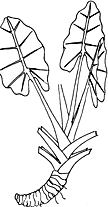View crop
View crop Data sheet EcoPortAlocasia macrorrhizos
 |
|
| Notes |
|---|
| BRIEF DESCRIPTION A large, erect herb, 2-4 m tall with thickened stems, up to 3 m or more in height and 20 cm in diameter. Leaves up to 1 m in length. USES The stem is peeled and used as a cooked vegetable, being added to soups and stews. The corms should be thoroughly cooked before eating. A very easily digested starch or flour can be prepared from the stem. The leaves and stalks of some cultivars are edible. KILLING T Sensitive to low temperature. GROWING PERIOD Herb, mature after 400-600 days. COMMON NAMES Giant taro, Giant alocasia, Alavu, Alu, Sente, Birah, Kape, Uvea, Toyoeu. FURTHER INF Giant taro is native of India, Malaysia and Sri Lanka. Elevations in the tropics below 1000 m are generally suitable. | Sources |
| SOURCES (A. macrorrhiza (L.) Schott) Tindall H 1983 pp 49 [TEXT, FER, DRA, TEMP, RAIN] Roecklein J 1987 pp 250 [USE] Duke J 1975 pp 6 [PH, RAIN, TEMP] Purseglove J 1972 pp 58 [USE] Voortman R 1994 (pers. comm.) |